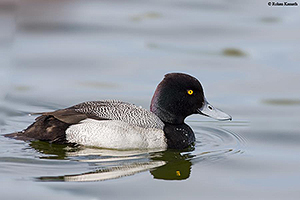
|
Lesser Scaup
Aythya affinis |
|
|
STANFORD LOCATIONS: Uncommon winter visitor in more open, deeper water at Lagunita. |
 |
Location |
Type |
Mating System |
Parental Care |
2ndary Diet |
Strategy |
|
|
|
|
I: 21-28 DAYS PRECOCIAL 2 |
|
|
|
|
(8-14) MONOG |
F |
PLANTS |
| BREEDING: | Often upland areas near pond or small lake, marsh, prairie potholes. 1 brood. |
| DISPLAYS: | See: Duck Displays. |
| NEST: | In fairly open, dry habitat within 150' of water, nest concealed by veg, rarely over water. Lined with grass, down; uses less down in nest than do other ducks. Built as eggs are laid. |
| EGGS: | Olive/olive-buff. 2.3" (57 mm). |
| DIET: | Aquatic invertebrates, esp amphipods; aquatic veg. |
| CONSERVATION: | Winters s throughout C.A. and West Indies to n S.A. |
| NOTES: | Male deserts when incubation begins, occ remains until middle of incubation. Young led to water; if disturbed, dive and disperse. Young form crèches, several broods often combined and tended by 1-3 females. Nests holding >14 eggs are due to >1 female laying in nest. Clutch size increases with age of female; nest success of females >2 years old is greater than that of 1- and 2-year-old females. Occ feeds at night. Large winter flocks, occ with Greater Scaup. |
| ESSAYS: | Eye Color; Bird Communities and Competition; Metallic Poisons; Dabblers vs. Divers; Crèches; Parasitized Ducks; Variation in Clutch Sizes. |
| REFERENCES: | Afton, 1984; Bellrose, 1976; Gooders and Boyer, 1986. |
| Help | Abbreviations | Species-Alphabetical | Species-Taxonomic | Essays-Alphabetical | |
| Except for Stanford Locations, the material in this species treatment is taken, with permission, from The Birder's Handbook (Paul Ehrlich, David Dobkin, & Darryl Wheye, Simon & Schuster, NY. 1988). | |||||